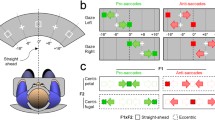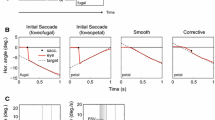Abstract
We examined the sensory and motor influences of stimulus eccentricity and direction on saccadic reaction times (SRTs), direction-of-movement errors, and saccade amplitude for stimulus-driven (prosaccade) and volitional (antisaccade) oculomotor responses in humans. Stimuli were presented at five eccentricities, ranging from 0.5° to 8°, and in eight radial directions around a central fixation point. At 0.5° eccentricity, participants showed delayed SRT and increased direction-of-movement errors consistent with misidentification of the target and fixation points. For the remaining eccentricities, horizontal saccades had shorter mean SRT than vertical saccades. Stimuli in the upper visual field trigger overt shifts in gaze more easily and faster than in the lower visual field: prosaccades to the upper hemifield had shorter SRT than to the lower hemifield, and more anti-saccade direction-of-movement errors were made into the upper hemifield. With the exception of the 0.5° stimuli, SRT was independent of eccentricity. Saccade amplitude was dependent on target eccentricity for prosaccades, but not for antisaccades within the range we tested. Performance matched behavioral measures described previously for monkeys performing the same tasks, confirming that the monkey is a good model for the human oculomotor function. We conclude that an upper hemifield bias lead to a decrease in SRT and an increase in direction errors.





Similar content being viewed by others
References
Abed F (1991) Cultural influences on visual scanning patterns. J Cross Cult Psychol 22:525–534
Bell AH, Everling S, Munoz DP (2000) Influence of stimulus eccentricity and direction on characteristics of pro- and antisaccades in non-human primates. J Neurophysiol 84:2595–2604
Cabel DWJ, Armstrong IT, Reingold E, Munoz DP (2000) Control of saccadic initiation in a countermanding task using visual and auditory stop signals. Exp Brain Res 133:431–441
Cornelissen FW, Kimmig H, Schira M, Rutschmann RM, Maguire RP, Broerse A, den Boer JA, Greenlee MW (2002) Event-related fMRI responses in the human frontal eye fields in a randomized pro-and antisaccade task. Exp Brain Res 145:270–274
Danckert J, Goodale MA (2001) Superior performance for visually guided pointing in the lower visual field. Exp Brain Res 137:303–308
Everling S, Fischer B (1998) The antisaccade: a review of basic research and clinical studies. Neuropsychologia 36:885–889
Fischer B, Ramsperger E (1984) Human express saccades: extremely short reaction times of goal directed eye movements. Exp Brain Res 57:191–195
Fischer B, Weber H (1992) Characteristics of “anti” saccades in man. Exp Brain Res 89:415–424
Fischer B, Weber H (1993) Express saccades and visual attention. Behav Brain Res 16:553–610
Fischer B, Weber H (1997) Effects of stimulus conditions on the performance of antisaccades in man. Exp Brain Res 97:191–200
Fischer B, Biscaldi M, Gezeck S (1997) On the development of voluntary and reflexive components in human saccade generation. Brain Res 754:285–297
Goldring J, Fischer B (1997) Reaction times of vertical prosaccades and antisaccades in gap and overlap tasks. Exp Brain Res 97:88–103
Guitton D, Buchtel HA, Douglas RM (1985) Frontal-lobe lesions in man cause difficulties in suppressing reflexive glances and in generating goal-directed saccades. Exp Brain Res 58:455–472
Hallet PE (1978) Primary and secondary saccades to goals defined by instructions. Vision Res 18:1279–1296
He S, Cavanagh P, Intriligator J (1996) Attentional resolution and the locus of visual awareness. Nature 383:334–337
Kalesnykas RP, Hallett PE (1987) The differentiation of visually guided and anticipatory saccades in gap and overlap paradigms. Exp Brain Res 68:115–121
Kalesnykas RP, Hallett PE (1994) Retinal eccentricity and the latency of eye saccades. Vision Res 94:517–531
Kapoula Z (1985) Evidence for a range effect in the saccadic system. Vision Res. 25:1155–1157
Klein C, Fischer B (2005) Developmental fractionation and differential discrimination of the anti-saccadic direction error. Exp Brain Res 165:132–138
Krappmann P, Everling S, Hans F (1998) Accuracy of visually and memory-guided antisaccades in man. Vision Res 38:2979–2985
Krauzlis RJ, Miles FA (1996) Release of fixation for pursuit and saccades in humans: evidence for shared inputs acting on different neural substrates. J Neurophysiol 96:2822–2833
Kristjansson A, Chen Y, Nakayama K (2001) Less attention is more in the preparation of antisaccades, but not prosaccades. Nat Neurosci 4:1037–1042
Kristjansson A, Vandenbroucke MWG, Driver J (2004) When pros become cons for anti- versus prosaccades: factors with opposite or common effects on different saccade types. Exp Brain Res 155:231–244
Munoz DP, Corneil B (1995) Evidence for interactions between target selection and visual fixation for saccade generation in humans. Exp Brain Res 103:168–173
Munoz DP, Everling S (2004) Look away: the anti-saccade task and the voluntary control of eye movement. Nat Rev Neurosci 5:218–228
Munoz DP, Broughton JR, Goldring JE, Armstrong IT (1998) Age-related performance of human subjects on saccadic eye movement tasks. Exp Brain Res 121:391–400
Munoz DP, Armstrong IT, Coe B (2005) Using eye movements to probe development and dysfunction. In: Proceedings of the 13th European conference on eye movements
Pierrot-Deseilligny C, Rivaud S, Gaymard B, Muri R, Vermersch AI (1995) Cortical control of saccades. Ann Neurol 95:557–567
Previc FH (1990) Functional specialization in the lower and upper visual fields in humans: its ecological origins and neurophysiological implications. Behav Brain Sci 13:519–575
Reingold E, Stampe D (2002) Saccadic inhibition in voluntary and reflexive saccades. J Cogn Neurosci 14:371–388
Saslow MG (1967) Effects of components of displacement-step stimuli upon latency for saccadic eye movement. J Opt Soc Am 57:1024–1029
Van Opstal AJ, van Gisbergen JAM (1989) Scatter in the metrics of saccades and properties of the collicular motor map. Vision Res 29:1183–1196
Weber H, Fischer B (1995) Gap duration and location of attention focus modulate the occurrence of left/right asymmetries in the saccadic reaction times of human subjects. Vision Res 35:987–998
Weber H, Aiple F, Fischer B, Latanov A (1992) Dead zone for express saccades. Exp Brain Res 89:214–222
Wenban-Smith MG, Findlay JM (1991) Express saccades—is there a separate population in humans. Exp Brain Res 87:218–222
Acknowledgments
A. Bell, B. Corniel, S. Everling, R. Flanagan, K. Moore, L. Snell and B. Coe commented on an earlier version of the manuscript. This work was supported by the Canadian Institutes of Health Research and the Canada Research Chair Program.
Author information
Authors and Affiliations
Corresponding author
Rights and permissions
About this article
Cite this article
Dafoe, J.M., Armstrong, I.T. & Munoz, D.P. The influence of stimulus direction and eccentricity on pro- and anti-saccades in humans. Exp Brain Res 179, 563–570 (2007). https://doi.org/10.1007/s00221-006-0817-8
Received:
Accepted:
Published:
Issue Date:
DOI: https://doi.org/10.1007/s00221-006-0817-8




